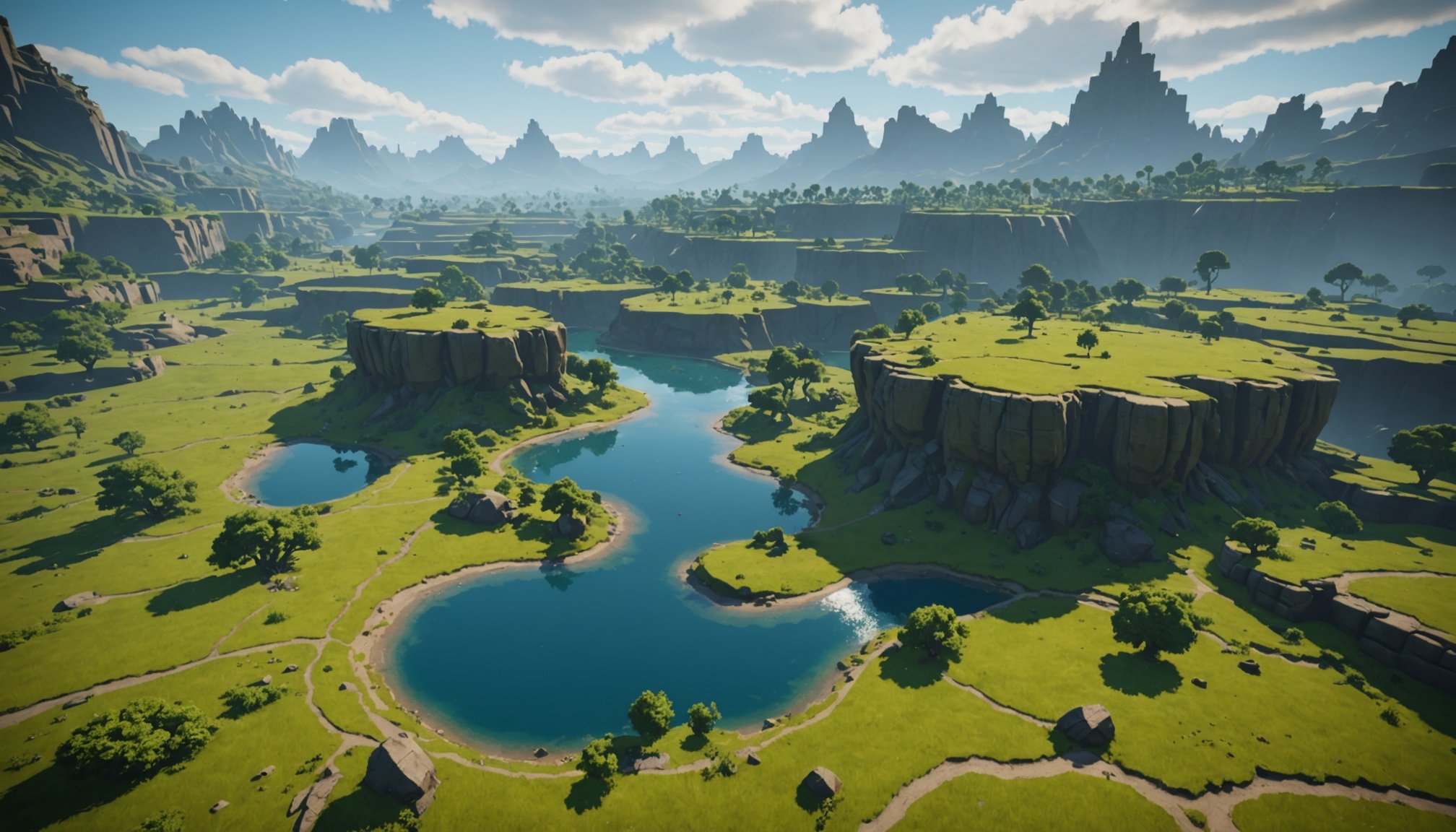Unveiling the Benefits and Drawbacks of Procedural Generation in Designing Vast Open-World Landscapes
The Revolution of Procedural Generation in Game Development
Procedural generation has been a game-changer in the gaming industry, particularly when it comes to designing vast open-world landscapes. This technique, which involves using algorithms to generate game content on the fly, has transformed how developers create, test, and deliver immersive gaming experiences.
What is Procedural Generation?
Procedural generation is a method of content creation where algorithms generate game elements such as levels, environments, and characters based on predefined parameters. This approach is particularly beneficial for open-world and role-playing games, where the sheer scale of the game world can be overwhelming to design manually.
In parallel : Revolutionizing gaming experience: harnessing ai for dynamic real-time lighting adjustments in games
For example, in the game No Man’s Sky, procedural generation is used to create an entire universe with millions of unique planets, each featuring diverse ecosystems and landscapes. This not only saves time and resources but also ensures that each player’s experience is unique, enhancing the replayability and immersion of the game[1][2].
Benefits of Procedural Generation
Increased Replayability
One of the most significant advantages of procedural generation is the ability to create almost infinite replayability. Since the game world is generated dynamically, players are likely to encounter new environments, challenges, and experiences each time they play.
Also read : Enhancing realism in social simulation games: how ai transforms authentic character interactions
- Unique Environments: Each playthrough can feature entirely new landscapes, terrains, and ecosystems, keeping the game fresh and exciting.
- Dynamic Level Design: Levels can be generated in real-time, ensuring that no two playthroughs are the same.
- Adaptive Difficulty: The game can adjust the difficulty level based on the player’s performance, providing a challenging yet enjoyable experience[3].
Efficient Development
Procedural generation significantly reduces the time and resources required for game development. Here are some ways it streamlines the process:
- Automated Content Creation: Algorithms can generate vast amounts of content, from terrain to NPCs, without the need for manual design.
- Reduced Production Costs: By automating content creation, developers can lower production costs and allocate resources to other critical aspects of game development.
- Faster Iteration: Developers can quickly test and iterate on different game elements without the need for extensive manual changes[2][3].
Enhanced Immersion
Procedural generation can create highly immersive game worlds by making them feel organic and dynamic.
- Realistic Landscapes: Techniques like Perlin noise and Simplex noise can generate natural-looking terrains and textures, enhancing the visual realism of the game world.
- Adaptive Soundscapes: AI algorithms can create adaptive soundscapes that respond to the player’s actions and the game environment, adding another layer of immersion[1][2].
Drawbacks of Procedural Generation
Complexity of Environments
While procedural generation offers many benefits, it also comes with its own set of challenges.
- Interoperability Issues: Synthesizing large, heterogeneous environments can be complex, and current methodologies often struggle to interoperate effectively.
- Data Requirements: Many AI approaches require large datasets to train algorithms, which can be a challenge for developers with limited data.
- User Interaction: Effective procedural generation often necessitates collaboration between algorithms and human designers, which can be time-consuming and require significant feedback loops[3].
Quality Control and Consistency
Ensuring the quality and consistency of procedurally generated content can be a significant challenge.
- Randomness vs. Logic: While procedural generation can create unique environments, it can sometimes result in illogical or unbalanced game worlds.
- Testing and Validation: Automated testing tools are essential to ensure that the generated content meets the desired standards, but this process can be resource-intensive.
- Player Expectations: Players may have certain expectations about the game world, and procedural generation must balance randomness with these expectations to maintain player satisfaction[2][3].
Practical Applications and Examples
Procedural Generation in Game Design
Here are some practical examples of how procedural generation is used in game design:
- Terrain Generation: In No Man’s Sky, algorithms create diverse landscapes, from mountains to valleys, ensuring a rich visual experience.
- Enemy Placement: AI can determine optimal locations for enemies based on player behavior, enhancing challenge and engagement.
- Resource Distribution: The placement of items and resources can be dynamically adjusted to maintain balance and encourage exploration[1][3].
Tools and Technologies
Several tools and technologies are available to support procedural generation in game development:
| Tool/Technology | Description | Benefits |
|---|---|---|
| Unity’s Muse Animate | Enables developers to perform complex tasks like character animation without extensive coding knowledge. | Allows developers to focus on creative aspects, enhances productivity and immersion[1]. |
| Unreal Engine 5’s World Partition | Divides the game world into manageable sections, optimizing performance and allowing for seamless streaming of open worlds. | Enhances performance, supports collaborative development, and improves the overall gaming experience[4]. |
| Ubisoft’s Ghostwriter | Uses AI to generate NPC dialogue, allowing for real-time player interactions without extensive manual scripting. | Creates dynamic and immersive game worlds, enhances player engagement[2]. |
Future of Procedural Generation
As AI and machine learning technologies continue to evolve, the future of procedural generation looks promising.
Advanced AI Models
Technologies like Generative Adversarial Networks (GANs) and Natural Language Processing (NLP) will play a crucial role in creating increasingly realistic and interactive worlds.
- GANs: Can produce unique game content, including levels, characters, and environments, enhancing the diversity and realism of the game world.
- NLP: Enables natural player-NPC interactions, enhancing story-driven games and creating more immersive experiences[1].
Personalized Experiences
AI can adapt levels and game content based on individual player skills and preferences, making games more accessible and enjoyable.
- Adaptive Difficulty: The game can adjust the difficulty level in real-time based on the player’s performance, ensuring a challenging yet enjoyable experience.
- Personalized Storylines: AI can analyze player choices and adjust narratives accordingly, creating a more personalized and engaging gameplay experience[3].
Procedural generation is a powerful tool in the arsenal of game developers, offering a range of benefits from increased replayability to enhanced immersion. However, it also presents challenges such as ensuring quality and consistency, managing complexity, and meeting player expectations.
As the gaming industry continues to evolve, it is clear that procedural generation will play an increasingly important role in shaping the future of game design. By understanding both the benefits and drawbacks of this technology, developers can harness its potential to create truly immersive and engaging gaming experiences.
Practical Advice for Developers
For developers looking to integrate procedural generation into their game development process, here are some practical tips:
- Start Small: Begin with simple procedural generation techniques and gradually scale up as you become more comfortable with the technology.
- Use Existing Tools: Leverage tools like Unity’s Muse Animate and Unreal Engine 5’s World Partition to streamline your development process.
- Test Thoroughly: Ensure that you have robust testing mechanisms in place to validate the quality and consistency of the generated content.
- Collaborate with Designers: Work closely with human designers to refine and improve the generated content, ensuring it meets your game’s vision and standards.
By embracing procedural generation and addressing its challenges, developers can create game worlds that are not only vast and detailed but also highly immersive and engaging for players.











